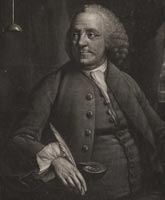Benjamin Franklin
Claimed by Trevor Craport
An article on Benjamin Franklin's life, scientific prowess, and effect on the world we live in today.
Personal Life
Benjamin Franklin was born on January 6th, 1706 in Boston, Massachusetts and died on April 17th, 1790 in Philadelphia, Pennsylvania. He attended Boston Latin School until the age of ten, but never did graduate; however, he did further his education through extensive reading and other self teaching methods for much of his life. Ben was a prominent figure in the beginning years of the United states and is known as one of the founding fathers of the country. Benjamin Franklin contributed in writing the Declaration of Independence, drafting the Articles of Confederation and writing the Constitution of the United States. After moving to Philadelphia in 1723, he became a printer. Franklin worked many professions and would continue to hop back and forth from the U.S and England until 1785 when he became the sixth president of the United States. Alongside founding the United States, he was also a leading author, a politician, a diplomat, and most significantly an inventor and scientist. Benjamin was a scientist during the scientific periods known as the American Enlightenment and the history of physics in which he played a key role in contributing a plethora of discoveries and inventions.
Scientific Achievements
Benjamin Franklin was an avid inventor and created a wide range of inventions ranging from the Franklin Stove to Bifocals; he even performed some experimentation on electrify developing a general theory that would later be used by Thomas Edison to fully understand the phenomenon known as electricity. Ones of his most well-known inventions was a signal-bell apparatus that would detect the presence of electrically charged clouds near by. This apparatus was mainly used with lightning in an effort to better understand and study lightning and the electrical energy that comes from it. From there, he would further his experimentation in electricity during the years 1747 to 1750. From his experimentation, Franklin was able to develop multiple new generalized theories: positive and negative charges, the electrical nature of lightning, and the protection from lightning using a tall, grounded rod. These theories later were combined into a category known as the theory of electrical "action" and earned him not only world recognition, but also a Copley Medal of Royal Society in 1753.
Future Implications of Franklin's Work
18th century America was a primitive, undeveloped landscape that, thanks to Franklin, was able to take a step forward from his fundamental contributions towards the science of electricity and his other inventions. Even with the lack of technology and other developments that Europe possessed, Benjamin Franklin was able to surpass any electrical discovery or achievement. Because of this, he was able to gain monumental support from other intellectuals in the New World as well as France in an effort to separate from the Old World. His discoveries sparked not only sparked the intellectual movement known as the Enlightenment, but it also provided the New World with enough technology to win its independence and thrive on its own as a newly formed country.
External links
http://www.let.rug.nl/usa/biographies/benjamin-franklin/a-short-biography.php https://www.loc.gov/exhibits/treasures/franklin-scientist.html http://www.britannica.com/biography/Benjamin-Franklin http://encyclopedia.gwu.edu/index.php?title=Benjamin_Franklin_University
References
Britannica Encyclopedia, GW Encyclopedia
